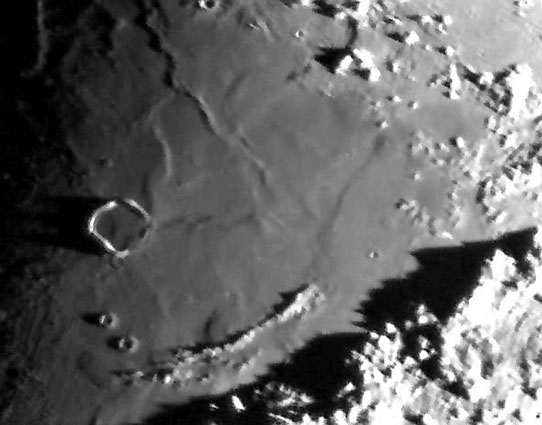Difference between revisions of "July 27, 2004"
| Line 9: | Line 9: | ||
<tr> | <tr> | ||
<td colspan="2"><div align="center"> | <td colspan="2"><div align="center"> | ||
| − | + | {{HoverImage|LPOD-2004-07-27.jpeg|}} | |
</div></td> | </div></td> | ||
</tr> | </tr> | ||
| Line 15: | Line 15: | ||
<table width="100%" border="0" cellpadding="8"> | <table width="100%" border="0" cellpadding="8"> | ||
<tr> | <tr> | ||
| − | <td><div align="center | + | <td><div align="center"><p>Image Credit: [mailto:r.laffoon@verizon.net Larry Laffoon]</p></div></td> |
</tr> | </tr> | ||
</table> | </table> | ||
Revision as of 16:26, 18 January 2015
What is a Dome?
Image Credit: Larry Laffoon |
|
What is a Dome? I know what a lunar dome is. Its a perfectly symmetrical mare rise, low-sloped and preferably topped with a summit pit. The Hortensius domes and the dome near Kies are the ideals of lunar domes. But I am broad minded, so I also call the steeper-sided, rougher textured, pitless low hills near Arago domes too. But I get more confused with irregular-shaped gentle rises on the maria. This sunrise image of southeastern Mare Imbrium just inside the Apennines provides a variety of examples of domical uncertainty. Other than the Apennine peak of Mt Huygens the only significant named feature here is the polygonal, rim-breached and lava flooded 26 km wide crater Wallace. But there are many low rises here, including 5 that I have numbered on the mouseover image. Number 1 looks like a classic dome - its round in outline, about 7 km wide, has clearly defined edges, and a slight brightening on the sun-facing slope and a hint of a shadow on the opposite one. It has no visible pit. And its isolated, not in contact with other features, Numbers 2 and 3 are more amorphous features. They are flat-topped and irregular outlined, although #2 could be described as sub-round. I don't know if I'd call these domes. Numbers 4 and 5 are similar to #3, but both butt up against ridges - does this make a difference? I have noticed that a number of non-circular, gentle-sloped, flat-topped rises surround or are attached to hills or ridges. And none of these irregular-shaped features ever seems to have a summit pit. Classic domes like Kies Pi are almost certainly the same types of features as small volcanic shield volcanoes such as occur famously in Iceland and the Snake River Plain in Idaho. Small shields are true volcanoes, erupting magma that rises from some depth, erupts thru a central vent and flows only a few kilometers away, building up the dome-shaped shield. But features like # 3, 4 and 5 may not be extrusions (surface eruptions) of lava. If they were, they would be expected to be about circular in outline because erupted lava would tend to flow the same distances in all directions. Probably, these irregular features are not surface eruptions - perhaps they are broad places where subsurface flowing magma has swelled up the surface. Such blisters occur commonly in terrestrial lava flows but they are only a few meters wide. Could a lunar blister be a few kilometers wide? Technical Details: Tomorrow's LPOD: A Surprise! |
Author & Editor: Technical Consultant: A service of: |
COMMENTS?
Register, and click on the Discussion tab at the top of the page.




